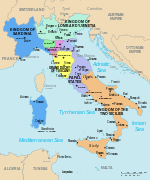Order of the Holy Sepulchre
Ordo Equestris Sancti Sepulcri Hierosolymitani | ||
Grand Prior | Latin Patriarch of Jerusalem, Pierbattista Pizzaballa OFM | |
Main organ | Council Complete of State | |
|---|---|---|
Parent organization | Holy See | |
| Affiliations | ||
| Website | www.oessh.va | |
Formerly called |
| |
The Equestrian Order of the Holy Sepulchre of Jerusalem (
Name
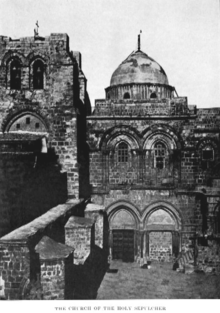
The name of the knights and order varied over the centuries, including Milites Sancti Sepulcri and The Sacred and Military Order of the Holy Sepulchre. The current name was determined on 27 July 1931 as the Equestrian Order of the Holy Sepulchre of Jerusalem (with of Jerusalem as honorary
History
The history of the Equestrian Order of the Holy Sepulchre of Jerusalem runs common and parallel to that of the religious Canons Regular of the Holy Sepulchre, the order continuing after the Canons Regular ceased to exist at the end of the 15th century (except for their female counterpart, the Canonesses Regular of the Holy Sepulchre).
Background
Pilgrimages to the Holy Land were a common, if hazardous, practice from shortly after the crucifixion of Jesus[4] to throughout the Middle Ages. Numerous detailed commentaries have survived as evidence of this early Christian devotion.[4] While there were many places the pious visited during their travels, the one most cherished was the Church of the Holy Sepulchre, first constructed by Constantine the Great in the 4th century AD.[5]
During the era of the
By virtue of its defining characteristic of
Persecution of Christians in the Holy Land intensified and relations with Christian rulers were further strained when Caliph Al-Hakim bi-Amr Allah ordered the destruction of the Church of the Holy Sepulchre in 1009.[10]
Crusades

The crusades coincided with a renewed concern in
Kingdom of Jerusalem (1099–1291)
After the
Between c. 1119–c. 1125,
In 1121,
In total, as a result of these military needs, five major
Today,
- the Order of Knights Templar no longer exists (other than its successor in Portugal – the Order of Christ),
- the Order of Saints Maurice and Lazarus is recognised as the successor to the medieval Order of Saint Lazarus,
- the successor to the Teutonic Order is a purely religious order of the Catholic Church,
- but both the Order of Malta and the Order of the Holy Sepulchre continue as chivalric orders recognised by the Holy See.
The
Meanwhile, beyond the Holy Land, in
In 15 July 1149 in the Holy Land, the
Crusade
I will that as soone as I am trespassed out of this worlde that ye take my harte owte of my body, and embawme it, and take of my treasoure as ye shall thynke sufficient for that enterprise, both for your selfe and suche company as ye wyll take with you, and present my hart to the holy Sepulchre where as our Lorde laye, seyng my body can nat come there.
Besides
The official arrival of the Franciscan
Franciscan Custody of the Holy Land (1291–1489)
The ultimate fall of the
The friars quickly resumed possession of their convent of Mount Zion at Jerusalem. The Turks tolerated the veneration paid to the tomb of Christ and derived revenue from the taxes levied upon pilgrims. In 1342, in his bull
With the emergence of the
Documented from 1335, the Franciscan Custody enrolled applicants as Knights of the Holy Sepulchre in ceremonies frequently mentioned in the itineraries of pilgrims. Those pilgrims deemed worthy received the honour in a solemn ceremony of ancient chivalry. However, in the ceremonial of reception at the time, the role of the clergy was limited to the
Post misam feci duos milites nobiles supra selpulchram gladios accingendo et alia observando, quae in professione militaris ordinis fieri consueverunt. |
After Mass, I made two [of my companions] noble knights of the Sepulchre by girding them with swords and by observing those other things, which in the profession of the knightly order have been accustomed to be done.[27] |
| —Wilhelm von Boldensele (c. 1285–1338) |

In 1346, King
Duke

The significance of the pilgrimages is indicated by various commemorations of the knights. The
Some property of the Knights in Italy was transferred to the newly established Order of Our Lady of Bethlehem in 1459, but the merger proved a failure.[31] The Order of Our Lady of Bethlehem was suppressed almost as soon as it was founded and those orders whose goods the pope had transmitted to it were re-established.[32][33]
The
Franciscan Grand Magistry
From 1480 to 1495,
When the
Papal Grand Magistry (1496–1847)
In 1496,
The prerogative of dubbing Knights of the Holy Sepulchre was repeatedly confirmed by the Holy See; by Pope Leo X on 4 May 1515, by Pope Clement VII in 1527 and by Pope Pius IV on 1 August 1561.
The privileges of the order, recorded by its guardian in 1553 and approved by successive popes, included powers to:[26]
- Legitimise bastards
- Change a name given in baptism
- Pardon prisoners they might meet on the way to the scaffold
- Possess goods belonging to the Church even though they were laymen
- Be exempt from taxes
- Cut a man down from the gallows and to order him to be given a Christian burial
- Wear brocaded silk garments
- Enter a church on horseback
- Fight against the infidel
In France, King Henry IV of France purchased its French possessions and incorporated them into his newly established Order of Our Lady of Mount Carmel, formally established by Pope Paul V through the bull Romanus Pontificus on 16 February 1608 and expanded through Militantium ordinum dated 26 February 1608, along with possessions of other orders which apparently were all deemed extinct and abolished, indicating reduced regional activity.[38]
Nonetheless, the dubbing and the privileges enjoyed continued confirmation, by
Knights of the Holy Sepulchre dubbed during this era include Hieronymus von Dorne (circa 1634) and François-René de Chateaubriand (1806).
Restoration of the Latin Patriarchate of Jerusalem (1847)
Pope
In 1932,
Protection of the Holy See (from 1945)
In 1945, Pope
The current Constitution of the Order was approved by Pope
Organisation
The order today remains an order of chivalry and is an association of the faithful with a legal canonical and public personality, constituted by the
Purpose and activities
Its principal mission is to reinforce the practice of Christian life by its members in absolute fidelity to the pope; to sustain and assist the religious, spiritual, charitable and social works and rights of the
Regional activities include participation in local processions and religious ceremonies, such as during Holy Week.
In
Grand Masters and Grand Magisterium

In 1496, Pope Alexander VI vested the office of Grand Master in the papacy where it remained until 1949.[3] Since 1949, cardinals have held the office. The incumbent Cardinal Grand Master has been Fernando Filoni since 2019.
The Grand Magisterium also includes:
- Latin Patriarch of Jerusalem and Cardinal-Priest of Sant'Onofrio al Gianicolo, Grand Prior of the Order[43]
- Tommaso Caputo, Prelate of the Territorial Prelature of Pompei, Assessor of the Order[43]
- Count Agostino Borromeo, Lieutenant General of Honor[43]
- Count Leonardo Visconti di Modrone, Governor General[43]
- P. Thomas Pogge, Vice-Governor General for North America[43]
- Jean-Pierre Glutz-Ruchti, Vice-Governor General for Europe[43]
- John Secker, Vice-Governor General for Asia and the Pacific region[43]
- Enric Mas, Vice-Governor General for Latin America[43]
- Alfredo Bastianelli, Chancellor of the Order
- Fortunato Frezza, Canon of St Peter's Basilica, Master of Ceremonies of the Order[44]
The offices of the Grand Magisterium are in the headquarters in Rome.[45]
Headquarters
Its headquarters are situated at the Palazzo Della Rovere in
Insignia

Heraldry
By ancient tradition, the order uses the arms attributed to the
Above the shield of the armorial bearings is a sovereign's gold helmet upon which are a crown of thorns and a terrestrial globe surmounted by a cross, flanked by two white standards bearing a red Jerusalem cross. The supporters are two angels wearing dalmatic tunics of red, the one on the dexter bearing a crusader flag, and the one on the sinister bearing a pilgrim's staff and shell: representing the military/crusading and pilgrim natures of the order.
The motto is
The Order of the Holy Sepulchre and the Sovereign Military Order of Malta are the only two institutions whose insignia may be displayed in a clerical coat of arms.[48]
Heraldic representation in coat of arms of members of the order
| |||
|---|---|---|---|
 Cardinal Grand Master Arms are quartered with those of the Order |
Grand Priors by those of the Order
Arms are impaled |
Lay members Arms are placed on the cross of the Order (not transmissible) | |
Vestments

The order has a predominantly white-coloured
The choir vestments of Canons of the Holy Sepulchre include a black cassock with magenta piping, magenta fascia, and a white mozetta with the red Jerusalem cross.
Membership
The order today is estimated to have some 30,000 knights and dames in 60 Lieutenancies around the world, including
Membership of the order is by invitation only, to practicing Catholic men and women – laity and clergy – of good character, minimum 25 years of age,[41] who have distinguished themselves by concern for the Christians of the Holy Land. Aspirant members must be recommended by their local bishop with the support of several members of the order, and are required to make a generous donation as a "passage fee", echoing the ancient practice of crusaders paying their passage to the Holy Land, as well as an annual financial offering for works undertaken in the Holy Land, particularly in the Latin Patriarchate of Jerusalem, throughout their life. There is a provision for the grand master to admit members by motu proprio in exceptional circumstances and also for the officers of the Grand Magistery to occasionally recommend candidates to the grand master.[50]
The honour of
Knights and dames of the order may not join, or attend the events of, any other order that is not recognised by the Holy See or by a sovereign state, and must renounce any membership in such organisations before being appointed a knight or dame of the Holy Sepulchre. Knights and dames may be expelled from the order in circumstances where they breach its code of conduct.[51]
Ranks
There are several grades of knighthood. These are open to both men and women. While
| Rank insignia (knights) | ||||
|---|---|---|---|---|
 | ||||
| Heraldry (Knights) | ||||
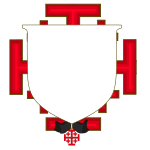 |
 |
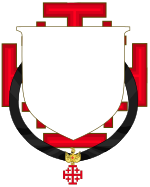 |
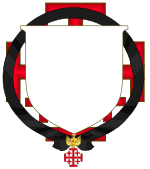 |
 |
| In the above depictions, the cross behind the shield should only be borne by archbishops, bishops, prelates and those with a title of nobility. | ||||
| Ribbons by rank | ||||
Below are shown the official titles of the ranks in English[52] (Italian, French, German, Spanish):[53]
- Knight / Dame of the Collar
(Cavaliere/Dama di Collare, Chevalier/Dame de Collier, Kollar-Ritter/-Dame, Caballero/Dama de Collar) - Knight / Dame Grand Cross (KGCHS / DGCHS)[54]
(Cavaliere/Dama Gran Croce, Chevalier/Dame de Grand Croix, Großkreuz-Ritter/-Dame, Caballero/Dama de Gran Cruz) - Knight Commander with Star / Dame Commander with Star (KC*HS / DC*HS)
(Grand'Ufficiale, Grand Officier, Großoffizier, Commendator Grand Oficiale)
(Dama di Commenda con placca, Dame de Commande avec plaque, Komtur-Dame mit Stern, Dama de Encomenienda con Placa) - Knight / Dame Commander (KCHS / DCHS)
(Commendatore, Commandeur, Komtur, Comendator)
(Dama di Commenda, Dame de Commande, Komtur-Dame, Dama di Ecomendienda) - Knight / Dame (KHS / DHS)
(Cavaliere/Dama, Chevalier/Dame, Ordensritter/Dame, Caballero/Dama)
In English, a female member of this order is sometimes called "lady" in reaction to the US slang use of the term "dame" to refer to any woman. However, in accordance with standard chivalric practice in English, female members are called "dame" (from the Latin title Domina, Italian Dama, etc.) and this is the usual practice in most lieutenancies.[a]
Canons
In accordance with the origins of the order, and considered more consistent with ordained ministry than the military title of knight,
Saints and beatified members

- Saint Contardo of Este (1216 - 16 April 1249)
- Pope St Pius X (2 June 1835 – 20 August 1914)
- Blessed Giuseppe Benedetto Dusmet (15 August 1818 – 4 April 1894)
- Blessed Andrea Carlo Ferrari (13 August 1850 – 2 February 1921)
- Blessed Alfredo Ildefonso Schuster (18 January 1880 – 30 August 1954)
- Blessed Bartolo Longo[58] (10 February 1841 – 5 October 1926)
- Blessed Aloysius Viktor Stepinac (8 May 1898 – 10 February 1960)
Awards and distinctions
Reserved to members, the
| Awards of Special Distinction | |||
Since 1949, the Cross of Merit of the Order may also be conferred on meritorious non-members of the order, for example non-Catholics.[61] The original five classes were reduced to three in 1977.[61] Obtaining the Cross of Merit does not imply membership of the Order.[61]
| Decorations of Merit | ||
Although it shares the same symbol, the Jerusalem Pilgrim's Cross is not a decoration of the Order of the Holy Sepulchre. Pope Leo XIII created the award in 1901 but the Franciscan custodian of the Holy Land presents it to certain pilgrims in the name of the pope.[62]
Gallery
-
Entrance of the Church of the Holy Sepulchre.
-
Flag of the Order of the Holy Sepulchre over thePalazzo della Rovere.
-
The convent ofSant'Onofrio al Gianicolocontains the official church of the order.
-
Notre Dame de Paris in France, where the Relics of Sainte-Chapelleare exposed by the Knights of the Holy Sepulchre.
-
Inside Dresden Cathedral, 9 October 2010.
-
Procession in honour of Saint Liborius of Le Mans with Knights of the Holy Sepulchre together with Teutonic Knights in Paderborn, Germany.
See also
- Catholic Church in the Middle East
- Catholic Church in Israel
- Catholic Church in Palestine
- Catholic Church in Jordan
- Catholic Church in Cyprus
Notes
- orders of chivalry is usually the wife of a member although there are exceptions: for example female members of the British Order of the Gartermay be called either "Lady (Royal and/or Supernumerary) Companion" (but not simply "Lady") or "Knight (Royal and/or Supernumerary) Companion". There is no provision in the constitution to use other titles in English, such as "sir", for knights although this is occasionally used. In some English-speaking lieutenancies, and consistent with the constitution and diplomatic practice of using French, a knight is addressed as chevalier, abbreviated Chev. The Diploma of Investiture of the Order, written in Latin, uses the term "Equitem" and the corresponding certificate for the Pilgrim Shell uses the Latin title "Dominum".
- ISBN 978-0-905715-32-2.
Citations
- ^ a b c d "History - Equestrian Order of the Holy Sepulchre of Jerusalem".
- ^ a b c "About us". Equestrian Order of the Holy Sepulchre. Retrieved 29 December 2023.
- ^ a b c d "History". Equestrian Order of the Holy Sepulchre. Retrieved 29 December 2023.
- ^ a b "Pilgrimages to the Holy Land and Communities in the Holy Land | Encyclopedia.com". www.encyclopedia.com. Retrieved 21 August 2022.
- ^ "Evidence of Earliest Christian Pilgrimage to the Holy Land Comes to Light in Holy Sepulchre Church". The BAS Library. Retrieved 31 January 2024.
- JSTOR 289581.
- ISBN 9780517686355. Retrieved 21 June 2019.
Every knight has the power to create knights
- ISBN 978-0-520-22635-7. Retrieved 31 January 2024.
- S2CID 159106757.
- ^ Lev (1995), pp. 203, 205–208
- ^ McCracken, Laura (1905). Gubbio, Past & Present. D. Nutt. p. 26.
- ^ "Histoire du monde.net".
- ^ "History of the order form the Western Australia Lieutenancy website". Archived from the original on 18 February 2017. Retrieved 9 March 2015.
- ^ "Origins". Archived from the original on 11 January 2016. Retrieved 9 March 2015.
- ISBN 978-2-7578-1122-1)
- ^ Malcolm Barber, A. K. Bate, Letters from the East: Crusaders, Pilgrims and Settlers in the 12th–13th Centuries (Farnham, Surrey, England; Burlington, VT: Ashgate, 2010), p. 43
- .
- ^ "Crusades - Holy War, Jerusalem, Reconquest | Britannica". www.britannica.com. Retrieved 31 January 2024.
- S2CID 164251969.
- ^ Kennedy, Hugh (13 March 1994). "Chivalry Is Not Dead (Published 1994)". The New York Times. Retrieved 31 January 2024.
- ^ Pope Innocent II indeed did write Alfonso VII to just this effect, 10 June 1135 or 36 (Lourie 1995:645).
- ^ from Froissart's Chronicles, translated by John Bourchier, Lord Berners (1467–1533), E M Brougham, News Out Of Scotland, London 1926
- ^ "History - Equestrian Order of the Holy Sepulchre of Jerusalem". www.vatican.va. Retrieved 31 January 2024.
- S2CID 238052679, retrieved 31 January 2024
- ISBN 978-90-04-42371-8, retrieved 31 January 2024
- ^ a b Peter Bander van Duren, Orders of Knighthood and of Merit
- ^ Meindl, Maria Christine. "Wenn einer eine Reise tut, dann kann er was erzählen." (Matthias Claudius) das Heilige Land in spätmittelalterlichen Reiseberichten (Master of Philosophy thesis). p. 22. Retrieved 29 December 2023.
- ^ Janus Møller Jensen. Denmark and the Crusades. 2007 p.41
- ^ Johann Georg Kohl: Pilgerfahrt des Landgrafen Wilhelm des Tapferen von Thüringen zum heiligen Lande im Jahre 1461, Müller 1868, page 70
- ^ "Geschichtsquellen: Werk/2208". www.geschichtsquellen.de. Retrieved 5 May 2020.
- ^ Allgemeine encyclopädie der wissenschaften und künste in alphabetischer folge von genannten schrifts bearbeitet und herausgegeben von J. S. Ersch und J. G. Gruber, J. f. Gleditsch, 1828, S. 158 f.
- ^ Besse, Jean. "Bethlehemites." The Catholic Encyclopedia Vol. 2. New York: Robert Appleton Company, 1907. 23 June 2015
- ^ Trollope, Thomas Anthony (2 December 1834). "An encyclopædia ecclesiastica; or, A complete history of the Church" – via Google Books.
- ^ Georg Spalatin, Christian Gotthold Neudecker, Ludwig Preller: Historischer nachlass und briefe, 1851, page 89
- ISBN 348658877X, S. 177
- ^ "CATHOLIC ENCYCLOPEDIA: Order of Friars Minor".
- ^ "Official website of the Order of the Holy Sepulchre". Archived from the original on 19 April 2012.
- ^ Carlisle, Nicholas (2 December 1839). "A Concise Account of the Several Foreign Orders of Knighthood, and Other Marks of Honourable Distinctions, Especially of Such as Have Been Conferred Upon British Subjects, Together with the Names and Achievements of Those Galant Men, who Have Been Presented with Honorary Swords Or Plate, by the Patriotic Fund Institution". John Hearne – via Google Books.
- ^ H. Schulze: Chronik sämmtlicher bekannten Ritter-Orden und Ehrenzeichen, welche von Souverainen und Regierungen verliehen werden, nebst Abb. der Decorationen. Moeser 1855, S. 566 f.
- ^ "How has the Order of the Holy Sepulchre evolved over time?". Retrieved 26 July 2019.
- ^ a b c oessh.no
- ^ "Accueil - Notre Dame de Paris". Archived from the original on 26 September 2013. Retrieved 19 December 2015.
- ^ a b c d e f g h "The Grand Magisterium of the Order - Equestrian Order of the Holy Sepulchre of Jerusalem". www.vatican.va. Retrieved 3 November 2023.
- ^ "Grand Magisterium - Vatican". Grand Magisterium. Vatican. Retrieved 3 June 2019.
- ^ "Il Gran Magistero dell'Ordine Equestre del Santo Sepolcro di Gerusalemme".
- ^ "Key to Umbria: Perugia". Key to Umbria. Retrieved 29 December 2023.
- ^ "Constitution" (PDF). EOHSJ ~ Southwestern USA. Retrieved 29 December 2023.
- ^ Acta Apostolicae Sedis, 20 April 1915, extending and clarifying the Apostolic Constitution Militantis Ecclesiae of Innocent X, 19 December 1644, cited in "A Decree on Ecclesiastical Heraldry". The Ecclesiastical Review. 53: 75 (Latin), 82–83 (English). July 1915. Retrieved 13 December 2019.
- ^ "EOHSJ — Ceremonial Dress".
- ^ "Almanach de la Cour". Archived from the original on 6 August 2011. Retrieved 11 July 2011.
- ^ a b "Constitution". www.oessh.va. Retrieved 31 January 2024.
- ^ Ranks in the Order of the Holy Sepulchre - official website of the OESSH
- ^ "Congregazione per l'Educazione Cattolica".
- ^ "Members of the Order". EOHSJ Toronto. Retrieved 18 April 2019.
- ^ Canon 1898, Ordo S. Sepulchre, Romae,1894.
- ^ "New honorary Canon of the Holy Sepulchre in Brescia". 13 September 2012. Archived from the original on 4 November 2013. Retrieved 6 July 2013.
- ^ "Barbiconi Sartoria ecclesiastica".[permanent dead link]
- Equestrian Order of the Holy Sepulchre of Jerusalem. 2023. Archivedfrom the original on 2 February 2023. Retrieved 30 April 2023.
- ^ "scallop - bivalve". 20 May 2023.
- ^ a b "Palme von Jerusalem [Palma Hierosolymitani]". Künker Münzauktionen und Goldhandel (in German). Retrieved 17 August 2019.
- ^ ISBN 978-0-905715-32-2.
- ^ "The Decoration created by Leon XIII". Custodia Terrae Sanctae. Retrieved 17 August 2019.
Sources
- Blasco, Alfred J. (1998). The Modern Crusaders. PenRose. ISBN 0-9632687-7-5.
- Noonan, James Charles Jr. (1996). The Church Visible: The Ceremonial Life and Protocol of the Roman Catholic Church. Viking. p. 196. ISBN 0-670-86745-4.
- Noonan, Jr., James-Charles (2012). The Church Visible: The Ceremonial Life and Protocol of the Roman Catholic Church Revised Edition. Sterling-Ethos. p. 139. ISBN 978-1-4027-8730-0.
- Bander van Duren, Peter Orders of Knighthood and of Merit
- Sainty, Guy Stair. Order of the Holy Sepulchre The Order of the Holy Sepulcher
- Sainty, G. 2006. Order of the Holy Sepulchre. World Orders of Knighthood & Merit. Guy Stair Sainty (editor) and Rafal Heydel-Mankoo (deputy editor). United Kingdom: Burke's Peerage & Gentry. 2 Vol. (2100 pp).
Further reading
- De perenni Cultu Terra Sancta (1555), Venice 1572, by Boniface of Ragusa
- Liber De perenni Cultu Terrae Sanctae Et De Fructuosa eius Peregrinatione, Venice 1573, by Boniface of Ragusa
- Discours du voyage d'Outre Mer au Sainct Sépulcre de Iérusalem, et autres lieux de la terre Saincte, Lyon 1573, by Antoine Régnault
- Csordás Eörs, editor, Miles Christi, Budapest: Szent István Társulat, 2001, 963361189X





















